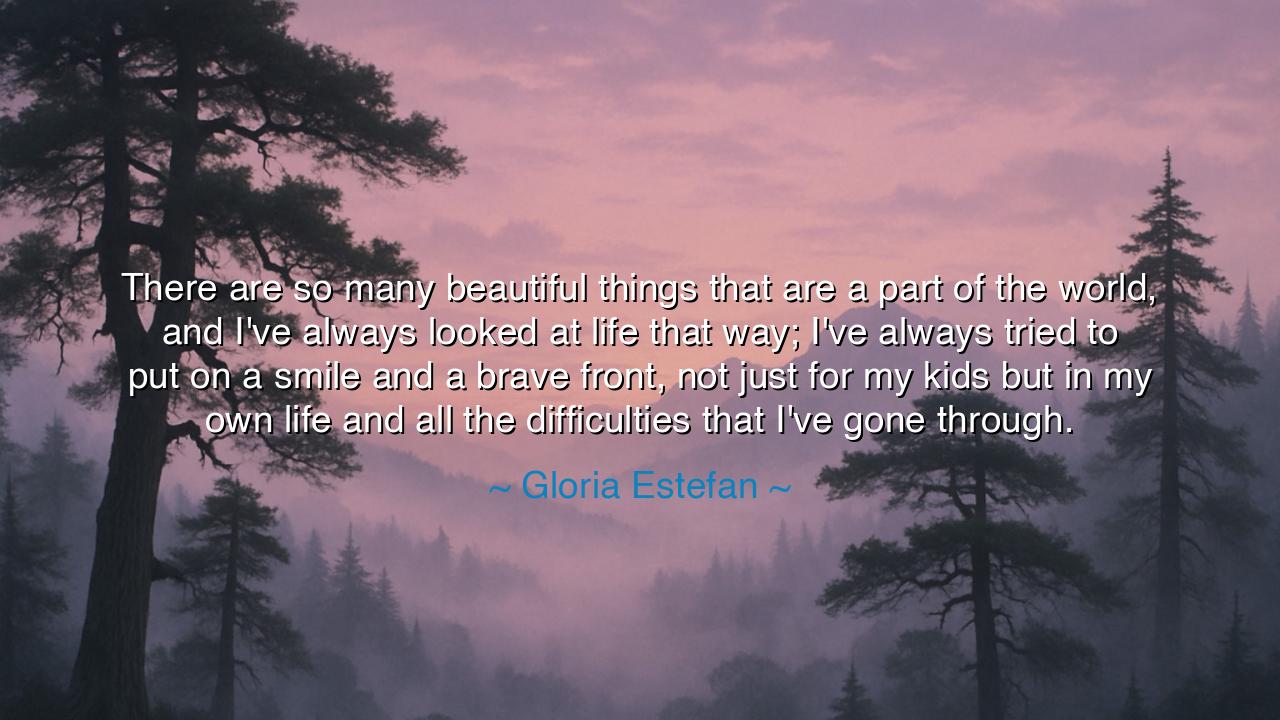
There are so many beautiful things that are a part of the world
There are so many beautiful things that are a part of the world, and I've always looked at life that way; I've always tried to put on a smile and a brave front, not just for my kids but in my own life and all the difficulties that I've gone through.






Hear the voice of Gloria Estefan, a woman who endured trial and rose triumphant, who said: “There are so many beautiful things that are a part of the world, and I’ve always looked at life that way; I’ve always tried to put on a smile and a brave front, not just for my kids but in my own life and all the difficulties that I’ve gone through.” In these words lies not only the confession of one artist, but the wisdom of the ages: that even amidst storms, one may choose to behold beauty, to wear courage, and to guard the hearts of others with strength.
The origin of her words is rooted in her own story. Gloria Estefan, beloved singer, nearly lost her ability to walk after a devastating bus accident in 1990. Yet she did not surrender to despair. She rose from the wreckage with iron will, with hope, and with a smile that shone brighter than the pain she bore. Her recovery was slow, filled with anguish and struggle, yet she placed before her family, her audience, and herself the shield of a brave front. In this, she revealed the ancient truth: that true strength is not the absence of sorrow, but the choice to meet sorrow with dignity.
The ancients spoke often of this. Consider the Stoics, who taught that though man cannot command the winds of fate, he can command the sails of his soul. Epictetus, born a slave and crippled, yet declared that happiness is found not in circumstance, but in attitude. Estefan echoes this wisdom when she speaks of seeing the beautiful things of the world despite difficulties. For to find beauty in hardship is to master life’s cruelest tests.
Her mention of her kids deepens the meaning. For the face of a mother is often the first mirror of strength a child sees. To hold a smile before her children even while wounded is no small feat—it is a sacrifice, a quiet heroism. It teaches that love is stronger than pain, that a parent’s duty is not only to provide food and shelter, but to shield the young from despair. In this way, the mother’s brave front becomes a fortress, and within its walls the children learn to face life with hope.
But this lesson is not for mothers only. It is for all who must stand as examples—teachers, leaders, friends, and companions. For every soul is watched by another, every act of courage or despair ripples outward. Estefan’s choice to wear a smile despite trial is a reminder that the light we hold can become the light by which others find their way. To live in bitterness is to cast shadows, but to live in hope is to kindle fire in those who follow.
The teaching here is not to deny suffering, nor to pretend that pain is not real. The teaching is to see both pain and beauty together, and to choose which to magnify. The world is filled with both thorns and roses, but the wise train their gaze upon the blossoms. Estefan, scarred but unbroken, chose to exalt beauty, and by doing so, she triumphed not only over her own wounds but over despair itself.
Therefore, beloved listener, take this counsel: when you face difficulties, look also for the beautiful things. When sorrow comes, stand with a brave front, not to deceive yourself, but to strengthen your spirit and those who look to you for courage. Wear the smile not as denial, but as a banner of resilience. And remember, as Estefan’s life proclaims, that joy is not the absence of pain—it is the triumph of hope over pain.






AAdministratorAdministrator
Welcome, honored guests. Please leave a comment, we will respond soon